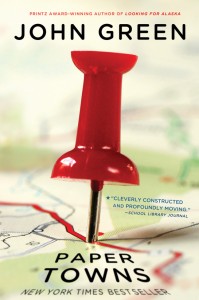 Margo Roth Speigelman, in book and new film Paper Towns, is the archetype of the Manic Pixie Dream Girl. She is troubled, yet she is unquantifiably cool. She is mysterious, yet she gives enough away to be loveable. She is different, yet she feels familiar, homely. She attracts rescue, yet she is independent. Her troubled, anguished, intriguing pain is what attracts Quentin Jacobson to her.
Margo Roth Speigelman, in book and new film Paper Towns, is the archetype of the Manic Pixie Dream Girl. She is troubled, yet she is unquantifiably cool. She is mysterious, yet she gives enough away to be loveable. She is different, yet she feels familiar, homely. She attracts rescue, yet she is independent. Her troubled, anguished, intriguing pain is what attracts Quentin Jacobson to her.
The John Green novel, the film even more so, begins almost predictably. (I’ll refer only to the book here; the book is better, despite how much I love Cara Delavigne.) “Oh great,” I thought, “yet another Manic Pixie Dream Girl.” For reference, Nathan Rabin describes MPDGs as a type of girl in films, TV, and books that “exist solely in the fevered imaginations of sensitive writer-directors to teach broodingly soulful young men to embrace life and its infinite mysteries and adventures.”
For the first two thirds of the book is completely and entirely a predictable MPDG story. Margo is an anguished, mysterious girl, teaching the shy boy, Quentin, to see the world in a new light. It‚Äôs predictability is equal parts exhausting and addictive. Read from Quentin’s perspective, you start to idealize her yourself.
Yet, two thirds in, the entire narrative is turned on its head. The entire notion of the MPDG is turned on its head. In an attempt to avoid spoilers to any great extent, it can be vaguely summed up that Quentin realizes that Margo isn’t an illusion, releasing that she is just an ordinary human. “The fundamental mistake I had always made—and that she had, in fairness, always led me to make—was this: Margo was not a miracle. She was not an adventure. She was not a fine and precious thing. She was a girl.”
John Green is an influential, immensely popular young adult writer; Paper Towns alone has sold 30 million copies. His novels are seemingly easy reading fun, I read Looking for Alaska in a day. Yet, he uses his influence, and ultimately his articulate writing talent, to impact the ‚Äòyoung adult‚Äô audience. Telling a young girl, ‚Äúyou don‚Äôt have to be perfect, you don‚Äôt exist for a boy’s use,‚Äù and telling a young boy, ‚Äúgirls are people too, they are flawed too,‚Äù is an impossibly powerful mission. A complex, challenging mission, that if read intently, is wholeheartedly achieved.
Paper Towns is devoted IN ITS ENTIRETY to destroying the lie of the manic pixie dream girl; the novel ends (this is not really a spoiler) with a young woman essentially saying, “Do you really still live in this fantasy land where boys can save girls by being romantically interested in them?” I do not know how I could have been less ambiguous about this without calling the novel ‘The Patriarchal Lie of the Manic Pixie Dream Girl Must Be Stabbed in the Heart and Killed.’”
–John Green
-Chloe Turner
Junior Girl
Girl Museum Inc.
